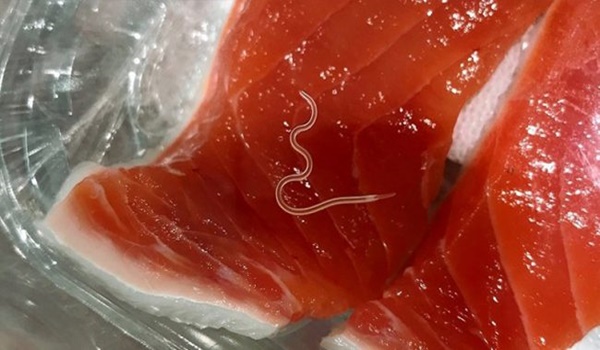If you love sushi, we might end up disappointing you, but that is not our intention. Yet, next time you are going out for this delicacy with your friends, make sure you are more mindful.
Namely, according to a report published in Global Change Biology on March 19, the rate of fish infected with the anisakis parasite has increased by 283 times since the 1970s.
Chelsea Wood at the University of Washington in Seattle and her colleagues analyzed the abundance of Anisakis, or herring worm, between 1978 and 2015.
They garnered data on the average number of parasites per fish from 123 studies, which involved 56,778 fish across 215 species.
These parasitic nematodes (worms) and are also known as whale worms and are found in marine life, including fish and mammals. They can grow up to 2 cm, and if consumed, they can lead to vomiting and diarrhea.
The infection is called Anisakiasis, and if it occurs, one develops symptoms such as abdominal pain, a tingling sensation, bloating, nausea, mild fever, blood or mucus in the stool, and allergic reactions.
These parasites are not contagious. So even if a person gets infected, the human-to-human transmission is impossible.
The 1967 analysis found more than 55,000 species of the worm in 215 different species of fish. In the late ‘70s, researchers found less than one worm per 100 fish.
Yet, now, they found more than one worm per individual fish! The primary host of the adult whale worms are whales, and all cetaceans are their ideal home.
Namely, the feces of cetaceans contains anisakis eggs, and when they defecate, these eggs remain in the environment. They hatch in water and become larvae, which are often consumed by crustaceans and mollusks. Krill, as a primary food source for fish and squid, is an important intermediate host.
The larvae encyst on the intestines and other visceral organs of the fish and squid, and once they are eaten by marine mammals, they grow, mate, and then eggs again.
The consumption of raw and uncooked fish and squid contaminated with the parasite makes us its host. Yet, the massive proliferation of these parasites might increase the risk for many of their hosts.
The problems are more serious for intermediate hosts. For instance, the Atlantic Salmon, if infected, develop red vent syndrome.
Wood adds:
“One of the important implications of this study is that now we know there is this massive, rising health risk to marine mammals. It’s not often considered that parasites might be the reason that some marine mammal populations are failing to bounce back. I hope this study encourages people to look at intestinal parasites as a potential cap on the population growth of endangered and threatened marine mammals.”
Therefore, she explains that they “ want to try and minimize the number of worms that people are encountering in their sushi dinner” and adds that “that is going to become more challenging into the future as we get these increasing abundances.”
There are several theories for the dramatic increase in the parasite population in the last four decades. As some shale populations are on the rebound, parasites might have got more hosts throughout the ocean.
This is a good sign, according to Wood:
“These worms might be a signal that things are getting better for ocean ecosystems. My gut feeling is that it’s about recovery to a prehuman baseline. In a pristine ocean, there were tons of marine mammals pooping out lots of Anisakis that infected fish in great abundance.”
However, this theory has yet to be studied.
Another possible explanation is that the parasites’ life cycles have been accelerated due to climate change and the warming up of ocean waters.
Meanwhile, what can you do to protect yourself? Well, cooking your fish will keep you on the safe side. Freezing fillets kills the parasites too, and farmed fish are rarely infected with them.
But sushi and sushimi pose a greater risk. If it comforts you, Wood still eats sushi, “all the time”!
She believes that sushi chefs are even better at spotting these worms in the fish than scientists, and they pick them out if they spot them! Therefore, she believes this you should not stop eating your favorite Japanese dish!
Sources: https://www.healthyfoodhouse.com/


